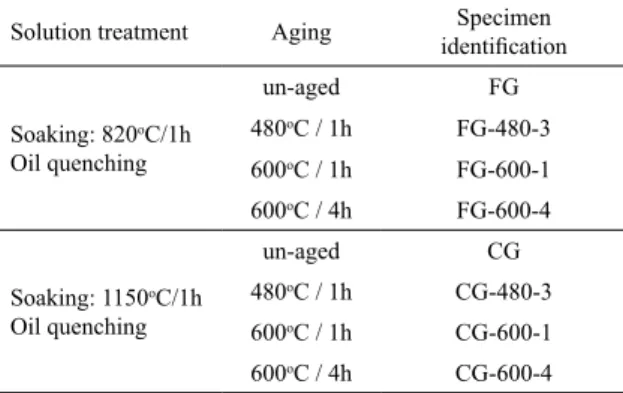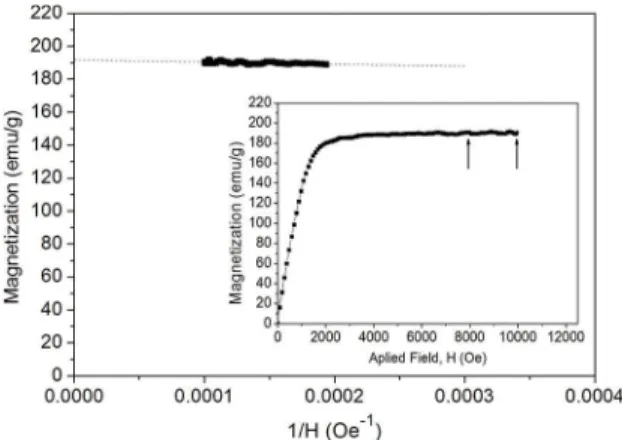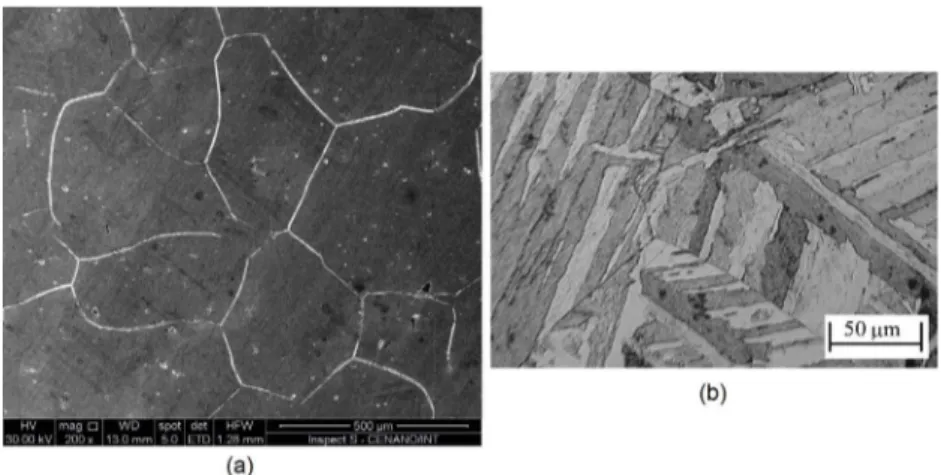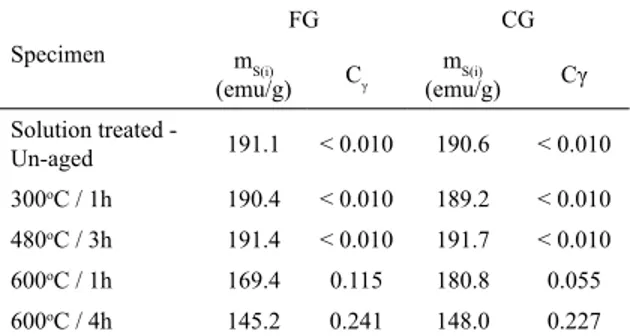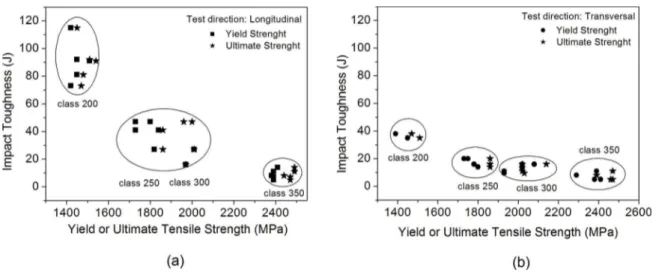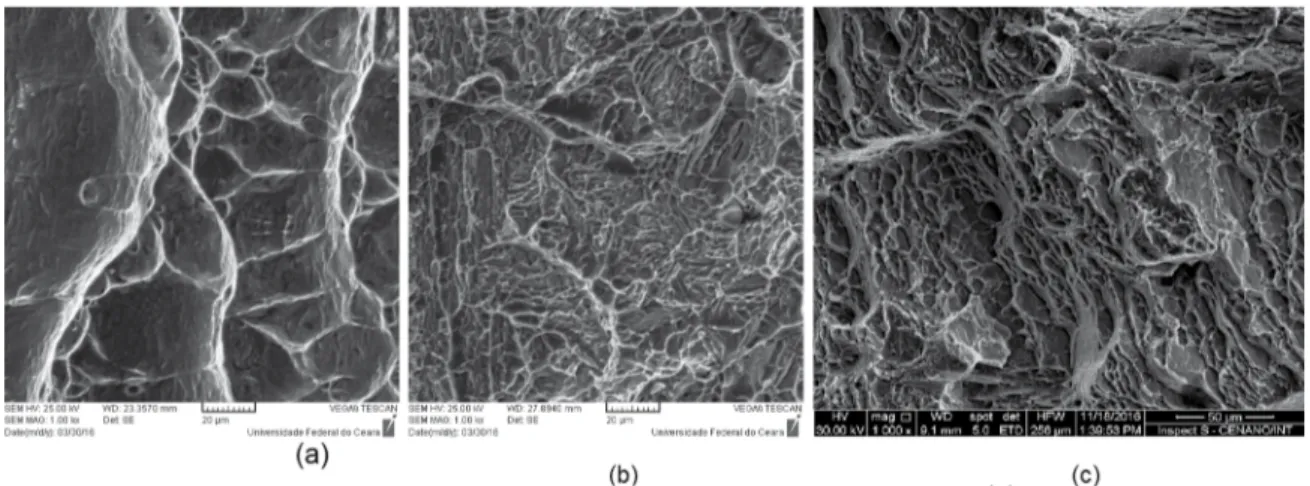Influence of Austenitizing on the Mechanical Properties of Maraging 300 and Sae 4340
Steels – Comparative Study
Sérgio Souto Maior Tavaresa,b*, Juan Manuel Pardala, Tabatta Regina de Brito Martinsc, Vanessa
Milhomem Schmittd, Jorge Felipe Veiga Szlejfa
Received: November 28, 2016; Revised: March 08, 2017; Accepted: April 05, 2017.
Maraging steels with 18wt%Ni and 10wt%Co are precipitation hardenable steels selected for special applications. These steels are quenched and aged in the 480 – 600oC range. Ti and Mo are added to
precipitate during aging as fine Ni3(Ti,Mo) and Fe2Mo particles. Aging at high temperatures causes
overaging due to coarsening of particles and austenite formation. SAE 4340 is a typical low alloy medium carbon steel for quenching and tempering. The best combination of mechanical properties is attained by quenching and tempering in the 650 – 670oC range. These two steels are selected for
services where an optimum combination of mechanical strength, toughness and fatigue resistance is required. In this work, the austenitizing temperature in the quenching treatment was varied in order
to evaluate the effects on microstructure and mechanical properties of both steels. The results showed that the effect of previous austenite grain size on the toughness was different in the two steels analyzed.
Keywords: maraging 300 steel; SAE 4340 steel; quenching and tempering; previous austenite grain size.
* e-mail: ssmtavares@terra.com.br
1. Introduction
The influence of grain size on the mechanical properties of metallic materials, specifically in steels, has been extensively
studied over the years. It is well known the strengthening
effect (Hall Petch relation) and the increase of toughness by grain refinement1.
The grain size of quenched and tempered (Q&T) steels is that of the previous austenite phase. This grain size is function of the austenitization temperature and time2-4. In
Q&T low alloy steels, such as SAE 4340, 4140, 8640 and others, the austenitizing temperature range for commercial heat treatments must be high enough to homogenize the austenite, but low enough to avoid the austenite grain
coarsening. Excessively coarse previous austenite grain size
may promote intergranular quenching cracks in this family of steels5. Other effect of the coarse austenite grain size in
low alloy Q&T steels is the increase of retained austenite, as observed in SAE 4340 steel3.
Maraging steels are solution treated (or quenched) and aged in temperatures in the range of 450oC to 650oC
depending on the microstructure and properties desired for
the final product6-7. The low carbon martensite produced by
solution treatment is soft and has high toughness. The aging reactions produce a strong strengthening attributed to the
precipitation of fine Ni3(Ti,Mo) and Fe2Mo particles 7-8. The
peak of hardness is attained with aging temperatures around 480oC. Aging at high temperatures, above 500oC, causes
coarsening of particles and austenite formation, which make the hardness decrease (overaging).
Maraging 300 and 350 steels may be substitutes for Q&T SAE 4340 steel, and virse-versa9. In the present work, the
effect of austenitizing temperature on the microstructure
and mechanical properties of a maraging steel class 300 and a low alloy medium carbon steel SAE 4340 were studied and compared.
2. Materials and experimental methods
The chemical compositions of a class 300 maraging steel and a SAE 4340 low alloy steel are shown in Table 1. Maraging was from a 11 mm plate cut from a forged cylinder with 250 mm of diameter, and the SAE 4340 steel was from hot rolled and normalized bar with 16 mm of diameter.
The maraging plate was cut and machined for approximate dimensions of Charpy specimens (57 x 11 x 11 mm3) and tensile
specimens. These specimens were heat treated by solution a Universidade Federal Fluminense, Rua Passo da Pátria n°156,Niterói-RJ, 24210-240, Brazil
b Programa de Pós-graduação em Engenharia de Materiais, Centro Federal de Educação Tecnológica
Celso Suckow da Fonseca - CEFET-RJ, Brazil
c Programa de Engenharia de Nanotecnologia, Universidade Federal do Rio de Janeiro, Av. Horácio
Macedo, 2030 - Centro de Tecnologia; Ilha do Fundão-RJ, 21945-970, Brazil
d Centro Federal de Educação Tecnológica Celso Suckow da Fonseca, Unidade Itaguaí, Rodovia Mário
treatment and aging following the parameters indicated in Table 2. Two solution treatment temperatures were used to
obtain different austenitic grain sizes: 1150oC (coarse
grain-CG) and 820oC (fine grain-FG). After solution treatment the
specimens were aged to different levels of strength.
Table 1. Chemical composition of maraging 300 and SAE 4340 steels.
Elements Ni Co Mo Al Cr Si Ti C Mn P S
Maraging 18.33 9.400 5.00 0.106 0.110 0.040 0.790 0.007 0.020 < 0.005 < 0.001
SAE 4340 1.781 --- 0.221 --- 0.739 0.348 --- 0.413 0.687 0.029 0.030
Table 2. Heat treatments parameters applied to maraging steel.
Solution treatment Aging Specimen
identification
Soaking: 820oC/1h Oil quenching
un-aged FG
480oC / 1h FG-480-3
600oC / 1h FG-600-1
600oC / 4h FG-600-4
Soaking: 1150oC/1h Oil quenching
un-aged CG
480oC / 1h CG-480-3
600oC / 1h CG-600-1
600oC / 4h CG-600-4
SAE 4340 steel was also cut and machined to approximate
dimensions of Charpy and tensile specimens before heat treatments. The specimens were then quenched and tempered
or double tempered, as defined in Table 3. Two austenitizing
temperatures were tested (860oC and 1060oC) in order to
obtain different previous austenite grain sizes.
After the heat treatments, the Charpy specimens were
machined to the final dimensions (55 x 10 x 10 mm3) with
V-notch. The tensile specimens were grinded with emery
paper grit 400 and 600 to remove oxidation layer.
The austenitic grain sizes of both the quenched SAE 4340 and the solution treated maraging 300 steels were measured by quantitative metallography with specimens mechanically polished and etched. The etching for SAE 4340 steel was a
solution with 100ml H2O, 4g of picric acid and 4g of FeCl3.
This etching is applied with cotton, alternating the application of detergent with glycerin and the etching solution for 3
Table 3. Heat treatments parameters applied to SAE 4340 steel.
Quenching Tempering identificationSpecimen
Soaking: 860oC/1h Oil quenching
un-tempered Q860
650oC / 1h Q860-T650
650oC / 1h + 650oC / 1h
Q860-DT650
Soaking: 1060oC/1h Oil quenching
un-tempered Q1060
650oC / 1h Q1060-T650
650oC / 1h + 650oC / 1h
Q1060-DT650
or 4 times. The maraging steel was electrolytically etched with a 10%Cr2O3 solution, applying a voltage of 30V. The grain sizes were measured by the intercept method as per ASTM E-11210.
For the general martensitic structure, both CG and FG specimens of maraging solution treated were etched with Marble’s solution (10g CuSO4, 50 ml HCl and 50 ml H2O) and SAE 4340 was etched with nital 2%.
Magnetic measurements in a Vibrating Sample Magnetometer (VSM) were performed to detect and quantify austenite in the various heat treatment conditions. Specimens with the geometry of small discs of 3.0 mm of diameter were used to obtain the magnetization curve M versus H, were M is
the magnetization and H is the magnetic field applied to the
sample. The magnetization saturation (ms) was determined
by extrapolation of the magnetization x 1/H for 1/H → 0,
as shown in Figure 1. The austenite volume fractions were calculated using the linear relations:
( )
C
M+
C
c=
1
1
( )
C
Mm
m
2
s i s
=
Q Vwhere CM and Cγ are the volume fractions of martensite and austenite respectively; ms is the magnetization saturation of the specimen; and ms(i) is the magnetization saturation of a specimen with 100% of martensite, which was produced by quenching and low temperature tempering (SAE 4340) or aging (maraging). For this reason, specimens of SAE 4340 quenched at 860oC and tempered in the 200-500oC
and specimens of maraging steel solution treated and aged at 300oC and 400oC were specially produced to be tested in
the VSM and determinate the mS(i) for each material. Tensile tests and Charpy impact tests with V-notched specimens were performed at room temperature. Fracture surfaces were observed in the scanning electron microscope after the Charpy tests. Three specimens per heat treatment condition were tensile tested and impact tested. The average values will be presented.
3. Results and discussion
3.1. Steel SAE4340
Figures 2(a-b) and 3(a-b) compare the microstructures of SAE 4340 quenched from 860oC and 1060oC, respectively.
Figure 1. Magnetization curve and curve of M x 1/H of specimen maraging GG. Determination of mS. 286x201mm (150 x 150 DPI)
Figure 2. Microstructure of specimen of SAE 4340 Q860: (a) Previous austenite grains; (b) general martenstic microstructure.
Figure 3. Microstructure of specimen of SAE 4340 Q1060: (a) Previous austenite grains; (b) general martensitic microstructure.
and FeCl3 solution described. The average austenite grain sizes of specimens quenched from 860oC and 1060oC were
8.3 ± 1.3 µm (ASTM 10.5) and 14.2 ± 0.9 µm (ASMT 9.0), respectively.
Low alloy martensite, also known as massive or lath martensite, is characterized by packets, while high alloy
martensite is acicular, with plates. In the case of SAE 4340
a mixed structure is expected. Comparing Figures 2(a) and
2(b), it can be inferred that the increase of the austenitic grain size favors the acicular morphology of the martensite. Table 4 shows the hardness, the magnetic results and the amount of retained austenite in as quenched SAE 4340 steel. The mS(i) value adopted was 219.2 emu/g, which corresponds to the specimen quenched at 860oC and tempered at 400oC.
The increase of austenitic grain size increases the retained austenite volume fraction. Also, the hardness decreases with the increase of retained austenite.
Table 5 shows the tensile properties of specimens of SAE 4340 quenched as well as quenched and tempered. Specimens quenched from 860oC and tempered at 650oC
show higher ductility, but slightly lower yield and tensile strengths than specimens quenched from 1060oC. For both
quenching temperatures (860oC and 1060oC) the double
tempering caused an increase of mechanical resistance, but
little effect on ductility was observed.
Table 4. Magnetic measurement of austenite volume fraction (Cγ)
and hardness HV10 of specimens of SAE 4340 quenched from
860oC and 1060oC.
Specimen mS(i) (emu/g) Cγ HV10
Q860 206.5 5.8 750 ± 30
Q1060 179.5 18.1 630 ± 25
Table 5. Tensile properties of SAE 4340 steel. (average values).
Specimen Yield strength (MPa) Ultimate Strength (MPa) Elongation (%) Area reduction (%)
Q860-T650 793 890 16.1 76.2
Q860-DT650 866 945 15.8 60.4
Q1060-T650 810 924 12.4 49.1
Q1060-DT650 931 995 12.1 50.2
Table 6. Impact properties of SAE 4340 steel.
Specimen Energy (J) Lateral expansion
(mm) Specimen Energy (J)
Lateral expansion
(mm)
Q860 7.5 0 Q1060 3.2 0
Q860-T650 91.0 1.05 Q1060-T650 86.0 0.70
Q860-DT650 98.5 1.88 Q1060-DT650 94.5 1.42
tempered also increased the impact energy. Figure 4 shows a comparison of the surface of fracture of specimens Q860 and Q860-DT650. The quenched material has an aspect of quasi-cleavage, while the specimen quenched and tempered at 650oC shows ductile fracture with dimples nucleated at
non-metallic inclusions.
Figures 5(a-b) and 6(a-b) compare the microstructures of maraging FG and CG, as solution treated. The average grain size of FG and CG were 58.4 ± 1.8 µm (ASTM 5.0) and 247.9 ± 0.5 µm (ASTM 0.7), respectively.
Table 7 shows the magnetic results and the quantification
of austenite in maraging steel. The low temperature aging did not increase the mS, which suggests that the solution treated specimens did not contain retained austenite, or its
volume fraction was insignificant, for both solution treatment
temperatures. The mS(i) was that of specimen solution treated at 820oC (FG), 191.1 emu/g, which is very close to the m
S
of the specimen CG (1150oC). Differently from the low
alloy SAE 4340, the increase of the austenite grain size did not increase the volume fraction of retained austenite in the solution treated specimens.
Austenite phase appears when maraging steels are aged at high temperatures, typically above 500oC8. Specimens aged at
600oC show volume fractions of the so called reverse austenite
increasing with aging time. However, from the comparison
of specimens FG-600-1 and CG-600-1 in table 7, it seems clear that the lower the austenitic grain size the higher is the initial kinetics of reverse austenite precipitation. Specimens aged at 600oC for 4 h show similar amounts of austenite.
Table 8 shows the tensile properties and hardness, while
Table 9 exhibits the impact Charpy results of maraging steel. Differently from the SAE 4340 low alloy steel, the higher
toughness in the maraging 300 steel is obtained in the as-quenched condition, and that of coarse grained material was superior to
the fine grained steel. The impact toughness increased from 80
J to 145 J with the increase of austenitic grain size from 58.4 ± 1.8 µm (ASTM 5.0) to 247.9 ± 0.5 µm (ASTM 0.7).
When the maraging steel is aged to the peak of hardness (480oC-3h) the toughness was very low. Furthermore, the aging
at 600oC for 1h also produced a very brittle microstructure,
and, the increase of aging time to 4 h, which increased the austenite content, caused a further decrease of toughness in CG and FG. It can be concluded that, under the conditions established in this work, reverse austenite does not improve the toughness of maraging 300 steel.
The grain coarse material presents both lower hardness and mechanical strength when aged at 480oC. As a consequence,
the properties of maraging 300 (UTS ≥ 2094 MPa) are
achieved only in the fine grained material.
Other works have investigated the effect of grain size on
mechanical properties of maraging 18%Ni steels11-13. Saul et
al.11 observed the increase of room temperature tensile strength
with grain refinement of austenite, in agreement to results
presented here. Also, Sinha et al.12 observed the increase of
fracture toughness of solution treated specimens with the increase of austenitizing temperature and, consequently, austenitic grain size. On the other hand, Rack13 reported
that the prior austenite grain size did not affect the fracture
toughness of unaged 18Ni maraging steel.
Figures 7(a), (b) and (c) show the surface fractures of specimens CG, CG-480-3 and CG-600-4. Solution treated specimen (CG) has large microvoids (dimples), while the brittle fractures of maraging 300 CG-480-3 and CG-600-4
are manly characterized by very small dimples. Portions of
cleavage or quasi-cleavage were rarely observed in these brittle fractures. The decrease of dimples size indicates
embrittlement. Hilders and Santana14 proposed an inverse
relation between the fracture toughness and the square root of the average dimple diameter.
3.2. Comparison between SAE 4340 and
maraging 300 steel
The maximum hardness and mechanical resistance of
Figure 4. Fracture surface of specimens (a) Q860 and (b) Q860-T650.
Figure 5. Microstructure of maraging 300 FG: (a) etching for previous austenite; (b) Marble’s etching.
Table 7. Magnetic measurement of austenite volume fraction (Cγ) of specimens of maraging 300.
Specimen
FG CG
mS(i) (emu/g) Cγ
mS(i)
(emu/g) Cγ
Solution treated -
Un-aged 191.1 < 0.010 190.6 < 0.010
300oC / 1h 190.4 < 0.010 189.2 < 0.010
480oC / 3h 191.4 < 0.010 191.7 < 0.010
600oC / 1h 169.4 0.115 180.8 0.055
600oC / 4h 145.2 0.241 148.0 0.227
Table 8. Tensile properties (YS = Yield strength, UTS=Ultimate Tensile Strength, El. = Elongation, RA = Reduction of area) and
Vickers Hardness of maraging steel specimens.
Specimen YS (MPa) UTS (MPa) El. (%) RA (%) (HV30)
FG 1028 1105 14.2 70.6 328 ± 4
FG-480-3 2119 2125 4.9 24.3 593 ± 11
FG-600-4 1380 1454 10.0 38.8 475 ± 3
CG 928 1002 14.3 76.4 318 ± 3
CG-480-3 1764 1777 4.3 16.8 575 ± 5
CG-600-4 1452 1577 5.3 27.8 490 ± 8
Table 9. Impact Charpy tests results of maraging 300.
FG CG
Specimen Energy (J)
Lat.
Exp.
(mm)
Specimen Energy (J)
Lat.
Exp.
(mm)
FG 80 0.6 CG 145 1.5
FG-480-3 16 0.2 CG-480-3 13 0.2
FG-600-1 16 0.1 CG-600-1 16 0.1
FG-600-4 14 0.1 CG-600-4 13 0.1
Figure 7. Surface of fracture of specimens (a) CG, (b) CG-480-3 and (c) CG-600-4 (same magnification).
toughness is too low and stress level is too high for any application in this heat treatment condition. Tempering between 400-600oC promotes temper embrittlement15, which can be
mitigated but not eliminated by the decrease of impurities levels. The optimization of mechanical properties of this steel is obtained with quenching and tempering in 600-670oC range. Double tempering promotes a small increase
of toughness. On the other hand, austenitizing temperatures as high as 1060oC are not recommended because the risk
of quench cracks.
Maraging steels show a typical inverse relation between toughness and mechanical resistance. The increase of strength level promotes the decrease of impact toughness, as shown in Figure 8 constructed with the data reported in by the Nickel Development Institute16. However, in the as solution
treated condition maraging steels have excellent toughness
with hardness and tensile properties comparable to SAE 4340 quenched and tempered or double tempered at 650oC.
Fig. 9 compares the engineering tensile curves of maraging 300 CG and SAE 4340 Q860-DT650, respectively. Table 10 compares the mechanical properties of the two steels (maraging 300 and SAE 4340) in the conditions in which they show higher toughness. Analyzing the options of Table 10, 18Ni maraging steel solution treated with high austenitizing temperature shows the best mechanical properties, although SAE 4340 has higher uniform elongation than maraging CG steel.
4. Summary and conclusions
A comparison between a maraging steel 18%Ni-10%Co
class 300 and a SAE 4340 steel considering different heat
Figure 8. Impact toughness and yield/ultimate strength of maraging 200, 350, 300 and 35016: (a) longitudinal and (b) transversal direction.
Figure 9. Nominal stress versus nominal strain curves of maraging CG (un-aged) and SAE 4340 Q-860-DT650.
Table 10. Comparison between maraging 300 and SAE 4340 processed for high toughness.
Steel/condition YS (MPa) UTS (MPa) El. (%) RA (%) Impact energy (J)
Maraging CG 928 1002 14.3 76.4 145
Maraging FG 1028 1105 14.2 70.6 80
4340 860-650 793 890 16.1 76.2 91.0
4340 860-D650 866 945 15.8 60.4 98.5
• The increase of the previous austenitic grain size ASTM 5.0 to ASTM 0.7 by raising the solution treatment temperature from 820oC to 1150oC
increased the toughness of maraging steel in the
un-aged (solution treated) condition. However, in the SAE 4340 steel the opposite and more expected
behavior was observed, i.e. the reduction of the previous austenite grain size from ASMT 9.0 to ASTM 10.5 improved the toughness of quenched as well as quenched and tempered specimens. • After aging at 480oC/3h or 600oC/1h and 4h the
maraging steel becomes brittle, with little difference
between the specimens with coarse and fine previous
austenitic grain.
• The properties of maraging 300 (σUTS≥ 2094 MPa) were achieved in the material solution treated at 820oC
(fine austenitic grain), but not in the material solution
treated at 1150oC (coarse austenitic grain), i.e., the
refinement of the austenite grain promoted some
strengthening of the martensite aged and un-aged. • Despite of the reverse austenite formation on aging 18Ni maraging steel at 600oC for 1h and 4h, and the
decrease of hardness, the Charpy impact toughness was as low as that of material aged at 480oC to the
peak of hardness. This result suggests that reverse austenite does not improve the toughness of 18Ni maraging steels.
• The brittle fracture surface of maraging steel specimens solution treated and aged at 480oC for
3h was characterized by dimples much smaller than the un-aged specimen. Similar behavior was observed in the specimens aged at 600oC for 4 h.
The surface of fracture of quenched SAE 4340 steel has an aspect of quasi-cleavage, while the specimen quenched and tempered at 650oC shows
ductile fracture with dimples nucleated at non-metallic inclusions.
did not cause the retention of austenite in solution treatment. On the other hand, the initial kinetics of austenite formation at 600oC was higher in the
specimen with finer austenitic grain.
5. Acknowledgements
Authors acknowledge the Brazilian Research Agencies
CNPq (Grant 305294/2014-8) and FAPERJ (E-26/203033/2015) for financial support.
6. References
1. Calcagnotto M, Ponge D, Raabe D. Effect of grain refinement to 1 μm on strength and toughness of dual-phase steels. Materials Science and Engineering: A. 2010;527(29-30):7832-7840.
2. Yang K, Qu WS, Kong FY, Su GY. Effects of solution treatment
temperature on grain growth and mechanical properties of high strength 18%Ni cobalt free maraging steel. Materials Science and Technology. 2003;19(1):117-124.
3. Ajus C, Tavares SSM, da Silva MR, Corte RRA. Magnetic
properties and retained austenite quantification in SAE 4340
steel. Revista Matéria. 2009;14(3):993-999.
4. Sinha PP, Sreekumar K, Natarajan A, Nagarajan KV. Grain growth in 18Ni 1800MPa maraging steel. Journal of Materials Science. 1991;26(15):4155-4159.
5. ASM International. ASM Handbook: volume 4: Heat Treating.
Materials Park: ASM International; 1991.
6. Wang G, Yan Y, Li J, Qiao L, Volinsky AA. Microstructure effect
on hydrogen-induced cracking in TM210 maraging steel.
Materials Science and Engineering: A. 2013;586:142-148.
7. Viswanathan UK, Dey GK, Asundi MK. Precipitation hardening
in 350 grade maraging steel. Metallurgical Transactions A. 1993;24(11):2429-2442.
8. Tewari R, Mazumder S, Batra IS, Dey GK, Banerjee S. Precipitation
in 18 wt% Ni maraging steel of grade 350. Acta Materialia. 2000;48(5):1187-1200.
9. Cardoso ASM, Abdala AJ, de Lima MSF, Bonjorni FM, Barboza
MJR, Bapstista CARP, et al. Study of Laser Welding and Heat Treatments Done in Different High Strength Steels: 4340, 300M,
Maraging 300. In: 22nd SAE Brasil International Congress and
Display; 2013; São Paulo, SP, Brazil.
10. ASTM International. ASTM E112 - 13 - Standard Test Methods for Determining Average Grain Size. West Conshohocken: ASTM International; 2013.
11. Saul G, Roberson JA, Adair AM. The effects of thermal treatment
and austenitic grain size and mechanical properties of 18pct Ni maraging steels. Metallurgical and Materials Transactions B. 1970;1(2):383-387.
12. Sinha PP, Sreekumar K, Babu NS, Pant B, Natarajan A, Nagarajan
KV. Development of heat treatment parameters to improve fracture toughness and grain size of an embrittled maraging steel. Journal of Heat Treating. 1992;9(2):125-131.
13. Rack HJ. The role of prior austenite grain size on the tensile
ductility and fracture toughness of 18Ni maraging steels. Scripta Metallurgica. 1979;13(7):577-582.
14. Hilders OA, Santana MG. Toughness and fractography and
austenitic type 304 stainless steel with sensitization treatments at 973K. Metallography. 1988;21(2):151-164.
15. Materkowski JP, Krauss G. Tempered martensite embrittlement in
SAE 4340 steel. Metallurgical Transactions A. 1979;10(11):1643-1651.
Erratum
In the article "Influence of Austenitizing on the Mechanical Properties of Maraging 300 and Sae 4340 Steels - Comparative Study", DOI number: http://dx.doi.org/10.1590/1980-5373-MR-2016-0884, published in Mat. Res. in May 02, 2017, in the page 6 where was written:
Figure 7. Surface of fracture of specimens (a) CG, (b) CG-480-3 and (c) CG-600-4 (same magnification)
Figure 7. Surface of fracture of specimens (a) CG, (b) CG-480-3 and (c) CG-600-4 (same magnification)
